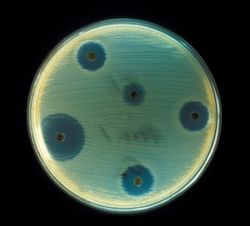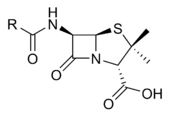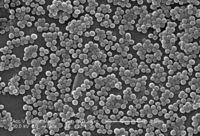مضاد حيوى
المضاد الحيويّ أو الصاد الحيوي هو مركّب أو دواء ينتج من بعض الفطريات أو يصنّع كيميائيًّا، ويقتل البكتيريا أو يساهم في تقليص نموّها، وليس له أيّ تأثير على الفيروسات أو الفطريّات.
تاريخ
رغم أن مفهوم المضادّ الحيويّ لم ينشأ إلّا في القرن العشرين إلّا أنّ استخدامها قد بدأ في الصين منذ أكثر من 2,500 سنة، وكثيرٍ من الحضارات القديمة كالحضارة الفرعونية والحضارة الإغريقية التي استعملت النباتات في علاج الكثير من الأمراض والعدوى دون التنبّه إلى المادّة الفعّالة داخل النباتات. في ألمانيا عام 1909 طوّر بول إرليخ (Paul Ehrlich) مضادًّا حيويًّا ضعيف المدى هو "سالفرسان" (Salvarsan) واستخدم في علاج السيلان الذى كان منتشرًا بكثرة في تلك الفترة. و كان الاكتشاف الحقيقيّ للمضادّات الحيويّة في إنجلترا عام 1928 بواسطة ألكسندر فلمينگ (Alexander Fleming) حيث اكتشف البينسلين. وبعد عشرة أعوام قام إرنست تشين Ernst B. Chain وهاورد فلوري Howard W. Florey بتحضير نوع صافٍ من البينسلين. وحصل الثلاثة على جائزة نوبل في الطب عام 1945.[1]
- Gastrointestinal upset and diarrhea
- Nausea (if alcohol taken concurrently)
- Allergic reactions
| Generic Name | Brand Names | الاستعمالات الشائعة | Possible Side Effects | آلية العمل |
|---|---|---|---|---|
| Aminoglycosides | ||||
| Amikacin | Amikin | Infections caused by Gram-negative bacteria, such as Escherichia coli and Klebsiella particularly Pseudomonas aeruginosa. Effective against Aerobic bacteria (not obligate/facultative anaerobes). | Binding to the bacterial 30S ribosomal subunit (some work by binding to the 50S subunit), inhibiting the translocation of the peptidyl-tRNA from the A-site to the P-site and also causing misreading of mRNA, leaving the bacterium unable to synthesize proteins vital to its growth. | |
| Gentamicin | Garamycin | |||
| Kanamycin | Kantrex | |||
| Neomycin | ||||
| Netilmicin | Netromycin | |||
| Streptomycin | ||||
| Tobramycin | Nebcin | |||
| Paromomycin | Humatin | |||
| Ansamycins | ||||
| Geldanamycin | Experimental, as antitumor antibiotics | |||
| Herbimycin | ||||
| Carbacephem | ||||
| Loracarbef | Lorabid | prevents bacterial cell division by inhibiting cell wall synthesis. | ||
| Carbapenems | ||||
| Ertapenem | Invanz | Bactericidal for both Gram-positive and Gram-negative organisms and therefore useful for empiric broad-spectrum antibacterial coverage. (Note MRSA resistance to this class.) |
|
Inhibition of cell wall synthesis |
| Doripenem | Finibax | |||
| Imipenem/Cilastatin | Primaxin | |||
| Meropenem | Merrem | |||
| Cephalosporins (First generation) | ||||
| Cefadroxil | Duricef |
|
Same mode of action as other beta-lactam antibiotics: disrupt the synthesis of the peptidoglycan layer of bacterial cell walls. | |
| Cefazolin | Ancef | |||
| Cefalotin or Cefalothin | Keflin | |||
| Cefalexin | Keflex | |||
| Cephalosporins (Second generation) | ||||
| Cefaclor | Ceclor |
|
Same mode of action as other beta-lactam antibiotics: disrupt the synthesis of the peptidoglycan layer of bacterial cell walls. | |
| Cefamandole | Mandole | |||
| Cefoxitin | Mefoxin | |||
| Cefprozil | Cefzil | |||
| Cefuroxime | Ceftin, Zinnat | |||
| Cephalosporins (Third generation) | ||||
| Cefixime | Suprax |
|
Same mode of action as other beta-lactam antibiotics: disrupt the synthesis of the peptidoglycan layer of bacterial cell walls. | |
| Cefdinir | Omnicef | |||
| Cefditoren | Spectracef | |||
| Cefoperazone | Cefobid | |||
| Cefotaxime | Claforan | |||
| Cefpodoxime | ||||
| Ceftazidime | Fortaz | |||
| Ceftibuten | Cedax | |||
| Ceftizoxime | ||||
| Ceftriaxone | Rocephin | |||
| Cephalosporins (Fourth generation) | ||||
| Cefepime | Maxipime |
|
Same mode of action as other beta-lactam antibiotics: disrupt the synthesis of the peptidoglycan layer of bacterial cell walls. | |
| Cephalosporins (Fifth generation) | ||||
| Ceftobiprole | ||||
| Glycopeptides | ||||
| Teicoplanin | inhibiting peptidoglycan synthesis | |||
| Vancomycin | Vancocin | |||
| Macrolides | ||||
| Azithromycin | Zithromax, Sumamed, Zitrocin | Streptococcal infections, syphilis, respiratory infections, mycoplasmal infections, Lyme disease |
|
inhibition of bacterial protein biosynthesis by binding irreversibly to the subunit 50S of the bacterial ribosome, thereby inhibiting translocation of peptidyl tRNA. |
| Clarithromycin | Biaxin | |||
| Dirithromycin | ||||
| Erythromycin | Erythocin, Erythroped | |||
| Roxithromycin | ||||
| Troleandomycin | ||||
| Telithromycin | Ketek | Pneumonia | Visual Disturbance, LIVER TOXICITY.[3] | |
| Spectinomycin | Antimetabolite, Anticancer | |||
| Monobactams | ||||
| Aztreonam | Same mode of action as other beta-lactam antibiotics: disrupt the synthesis of the peptidoglycan layer of bacterial cell walls. | |||
| Penicillins | ||||
| Amoxicillin | Novamox, Amoxil | Wide range of infections; penicillin used for streptococcal infections, syphilis, and Lyme disease |
|
Same mode of action as other beta-lactam antibiotics: disrupt the synthesis of the peptidoglycan layer of bacterial cell walls. |
| Ampicillin | ||||
| Azlocillin | ||||
| Carbenicillin | ||||
| Cloxacillin | ||||
| Dicloxacillin | ||||
| Flucloxacillin | Floxapen | |||
| Mezlocillin | ||||
| Meticillin | ||||
| Nafcillin | ||||
| Oxacillin | ||||
| Penicillin | ||||
| Piperacillin | ||||
| Ticarcillin | ||||
| Polypeptides | ||||
| Bacitracin | Eye, ear or bladder infections; usually applied directly to the eye or inhaled into the lungs; rarely given by injection | Kidney and nerve damage (when given by injection) | Inhibits isoprenyl pyrophosphate, a molecule which carries the building blocks of the peptidoglycan bacterial cell wall outside of the inner membrane [4] | |
| Colistin | Interact with the bacterial cytoplasmic membrane, changing its permeability. | |||
| Polymyxin B | ||||
| Quinolones | ||||
| Ciprofloxacin | Cipro, Ciproxin, Ciprobay | Urinary tract infections, bacterial prostatitis, community-acquired pneumonia, bacterial diarrhea, mycoplasmal infections, gonorrhea | Nausea (rare), tendinosis (rare) | inhibit the bacterial DNA gyrase or the topoisomerase IV enzyme, thereby inhibiting DNA replication and transcription. |
| Enoxacin | ||||
| Gatifloxacin | Tequin | |||
| Levofloxacin | Levaquin | |||
| Lomefloxacin | ||||
| Moxifloxacin | Avelox | |||
| Norfloxacin | Noroxin | |||
| Ofloxacin | Ocuflox | |||
| Trovafloxacin | Trovan | |||
| Sulfonamides | ||||
| Mafenide | Urinary tract infections (except sulfacetamide and mafenide); mafenide is used topically for burns |
|
Folate synthesis inhibition. They are competitive inhibitors of the enzyme dihydropteroate synthetase, DHPS. DHPS catalyses the conversion of PABA (para-aminobenzoate) to dihydropteroate, a key step in folate synthesis. Folate is necessary for the cell to synthesize nucleic acids (nucleic acids are essential building blocks of DNA and RNA), and in its absence cells will be unable to divide. | |
| Prontosil (archaic) | ||||
| Sulfacetamide | ||||
| Sulfamethizole | ||||
| Sulfanilimide (archaic) | ||||
| Sulfasalazine | ||||
| Sulfisoxazole | ||||
| Trimethoprim | ||||
| Trimethoprim-Sulfamethoxazole (Co-trimoxazole) (TMP-SMX) | Bactrim | |||
| Tetracyclines | ||||
| Demeclocycline | Syphilis, chlamydial infections, Lyme disease, mycoplasmal infections, acne rickettsial infections |
|
inhibiting the binding of aminoacyl-tRNA to the mRNA-ribosome complex. They do so mainly by binding to the 30S ribosomal subunit in the mRNA translation complex.[5] | |
| Doxycycline | Vibramycin | |||
| Minocycline | Minocin | |||
| Oxytetracycline | Terracin | |||
| Tetracycline | Sumycin | |||
| Others | ||||
| Arsphenamine | Salvarsan | Spirochaetal infections (obsolete) | ||
| Chloramphenicol | Chloromycetin | |||
| Clindamycin | Cleocin | acne infections, prophylaxis before surgery | ||
| Lincomycin | acne infections, prophylaxis before surgery | |||
| Ethambutol | Antituberculosis | |||
| Fosfomycin | ||||
| Fusidic acid | Fucidin | |||
| Furazolidone | ||||
| Isoniazid | Antituberculosis | |||
| Linezolid | Zyvox | |||
| Metronidazole | Flagyl | Giardia | ||
| Mupirocin | Bactroban | |||
| Nitrofurantoin | Macrodantin, Macrobid | |||
| Platensimycin | ||||
| Pyrazinamide | Antituberculosis | |||
| Quinupristin/Dalfopristin | Syncercid | |||
| Rifampin or Rifampicin | mostly Gram-positive and mycobacteria | Reddish-orange sweat, tears, and urine | Binds to the β subunit of RNA polymerase to inhibit transcription | |
| Tinidazole | ||||
| Generic Name | Brand Names | Common Uses | Possible Side Effects | Mechanism of action |
الانتاج
 مقالة مفصلة: انتاج المضادات الحيوية
مقالة مفصلة: انتاج المضادات الحيوية
أشهر المضادات الحيوية المستخدمة
- مجموعة البيتالاكتامات Betalactam ومنها مشتقات الأمبيسلّين ويتفرع منها الأموكسيسيلّين والمثبّت بواسطة حامض الكلافولينيك clavulinic acid
- مجموعة الماكروليد Macrolide مثل إيريتروميسن Erythromycin
- مجموعة الكينولون Quinolone: وأحدثها الجيل الرابع مثل moxifloxacin، الثالث مثل ليفوفلوكساسين levofloxacin وقبلها الجيل الثاني مثل سيبروفلوكساسين ciprofloxacin والجيل الأوّل مثل سينوكساسين cinoxacin.
مقاومة المضادات الحيوية
 مقالة مفصلة: مقاومة المضادات الحيوية
مقالة مفصلة: مقاومة المضادات الحيوية
المصادر
- ^ [1]
- ^ For common Uses and possible side effects reference is: Robert Berkow (ed.) The Merck Manual of Medical Information - Home Edition. Pocket (September 1999), ISBN 0-671-02727-1.
- ^
Splete, Heidi (2006). "Liver toxicity reported with Ketek". Internal Medicine News.
{{cite journal}}:|access-date=requires|url=(help); Unknown parameter|coauthors=ignored (|author=suggested) (help); Unknown parameter|month=ignored (help) - ^ Mechanism of Action of Bacitracin: Complexation with Metal Ion and C55-Isoprenyl Pyrophosphate K. John Stone and Jack L. Strominger
- ^ Life-Extension-Drugs.com - Doxycycline
وصلات خارجية
| Antibiotics
]].- Antibiotic News from Genome News Network (GNN)
- JAAPA: New antibiotics useful in primary care
- A new method for controlling bacterial activity without antibiotics - Research conducted at the Hebrew University
- BURDEN of Resistance and Disease in European Nations
- Antibiogram technique video
- European Surveillance of Antimicrobial Consumption (ESAC)
المراجع
- Bacteria Tower Defense - Antibiotic Coverage Resource and Game
- Alliance for the Prudent Use of Antibiotics
قالب:QuinoloneAntiBiotics قالب:PolypeptideAntiBiotics
|


